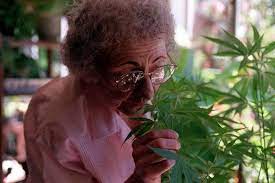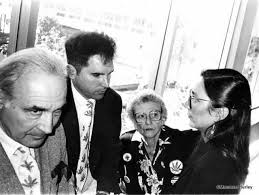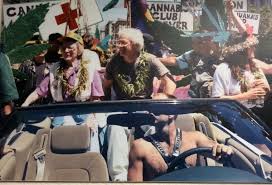How Mary Jane Changed the History of Medical Marijuana
2/25/2023 3:48 PM

How Mary Jane Changed the History of Medical Marijuana
Mary Jane Rathbun is the most historic woman in cannabis history and is single-handedly responsible for medicinal weed becoming legalized. Although it’s just a coincidence that she shares the nickname of her favourite green herb, it’s definitely fitting. Most fondly remembered as Brownie Mary, she created waves with her non-compliance to overly strict marijuana laws during her lifetime.
The Origin Story of A Community Legend
 It’s extremely hard to find any information on the early life of this courageous woman and a lot of what I did find wasn’t consistent. Everyone agrees that Mary was born into a highly religious family in 1922. Although she was born in Minnesota, she grew up in Chicago, where she was known to be rebellious from a very young age. Mary dropped out of school after hitting a nun who tried to cane her and left home to forge her own path as an activist. She found herself in Wisconsin battling for abortion rights and the union rights of miners. Like many young Americans during World War II, she made her way to the hub of civil disobedience, San Fransisco. This is where she met the man she would marry and start a family with, although it didn’t last very long, and they were soon divorced. As a single mother, her job waitressing at IHOP barely covered her bills, so she started selling pot brownies to make ends meet. Sadly, her only daughter died in a car crash in the 1970s, at only 22, which many of her friends think led to Mary’s dedication to charity work.
It’s extremely hard to find any information on the early life of this courageous woman and a lot of what I did find wasn’t consistent. Everyone agrees that Mary was born into a highly religious family in 1922. Although she was born in Minnesota, she grew up in Chicago, where she was known to be rebellious from a very young age. Mary dropped out of school after hitting a nun who tried to cane her and left home to forge her own path as an activist. She found herself in Wisconsin battling for abortion rights and the union rights of miners. Like many young Americans during World War II, she made her way to the hub of civil disobedience, San Fransisco. This is where she met the man she would marry and start a family with, although it didn’t last very long, and they were soon divorced. As a single mother, her job waitressing at IHOP barely covered her bills, so she started selling pot brownies to make ends meet. Sadly, her only daughter died in a car crash in the 1970s, at only 22, which many of her friends think led to Mary’s dedication to charity work.
Her First Arrest
 Mary Rathbun began selling her “magically delicious” brownies all over neighbourhood bulletin boards and quickly became well known throughout the city’s gay Castro District. In the early 80s, she was making up to 600 brownies a day and selling them either from her home, a basket on the streets, or the Big Top pot supermarket. Unfortunately, this widespread popularity attracted the attention of local police, who sent an undercover detective, posing as a customer, to her apartment. This feisty 57-year-old was arrested in her flower-print apron on January 14, 1981, when they confiscated almost 20 pounds of marijuana. The arrest made national headlines, but the judge liked her, and instead of sending this grandmotherly woman to jail, he sentenced her to 500 hours of community service. Most of her volunteer hours were spent on The Shanti Project, a support group for people living with life-threatening illnesses, which became a huge turning point in her life.
Mary Rathbun began selling her “magically delicious” brownies all over neighbourhood bulletin boards and quickly became well known throughout the city’s gay Castro District. In the early 80s, she was making up to 600 brownies a day and selling them either from her home, a basket on the streets, or the Big Top pot supermarket. Unfortunately, this widespread popularity attracted the attention of local police, who sent an undercover detective, posing as a customer, to her apartment. This feisty 57-year-old was arrested in her flower-print apron on January 14, 1981, when they confiscated almost 20 pounds of marijuana. The arrest made national headlines, but the judge liked her, and instead of sending this grandmotherly woman to jail, he sentenced her to 500 hours of community service. Most of her volunteer hours were spent on The Shanti Project, a support group for people living with life-threatening illnesses, which became a huge turning point in her life.
The AIDS pandemic
In 1982, the mysterious wasting disease that was running rampant through the community was finally named Acquired Immune Deficiency Syndrome (AIDS). Politicians widely ignored it as it mainly targeted gay communities, and many lost most of their friends as the death toll continued to rise. Mary was a beacon of light to the patients at the San Fransisco General Hospital, where she donated her time and her cannabis-laced baking. She noticed that her brownies helped ease the discomfort of cancer and AIDS patients while inducing hunger, significantly improving their quality of life. Brownie Mary stopped seeing her magical brownies as a way to make extra money and began using her small social security checks to buy baking supplies. She started to receive mysterious packages on her doorstep containing enough weed to continue her social welfare project. On December 1982, she was on her way to the hospital with her famous brownies when she was unlucky enough to run into the same officer that had arrested her the year before. Although she was charged with multiple counts of possession and violation of probation, the district attorney dropped the charges. By the mid- ‘80s, Mary was baking more than 1600 brownies a month for her “kids,” In 1986, she was awarded the prestigious “volunteer of the year” award.
The Third Arrest and Big Political Change
 In the early ‘90s, Mary came into her own as a political activist and contributed to Proposition P passing in 1991. This bill allowed physicians to prescribe medical marijuana to suffering patients without worrying that there would be legal consequences. Mary was no longer viewed as a rule breaker but as an aids activist who brought about change and well-being for people who received terrible diagnoses.
In the early ‘90s, Mary came into her own as a political activist and contributed to Proposition P passing in 1991. This bill allowed physicians to prescribe medical marijuana to suffering patients without worrying that there would be legal consequences. Mary was no longer viewed as a rule breaker but as an aids activist who brought about change and well-being for people who received terrible diagnoses.
“I know from smoking pot for over 30 years that this is a medicine that works. It works for wasting syndrome. The kids have no appetite, but when they eat a brownie, they get out of bed and make themselves some food. And for chemotherapy, they eat half a brownie before a session, and when they get out, they eat the other half. It eases the pain. That's what I'm here to do.” -Brownie Mary in an interview with Associated Press, 1992
All of Mary's fame did not stop her from getting arrested again in July 1992, but it did help her avoid any of the possession charges she faced. Soon after, the San Fransisco Board of Supervisors declared August 25th “Brownie Mary Day .”In 1996 Prop 215 passed, and less than two years later, Washington, Oregon, Alaska, and Nevada followed suit and legalized medical marijuana. Luckily Mary got to see all of this unfold, but her health had begun to deteriorate quickly. She now struggled with osteoarthritis, chronic obstructive pulmonary disease, and colon cancer. The only way Ruthbun could get around and keep fighting for what she believed in was cannabis which she had fought so hard to legalize. She stayed strong and was the grand marshal of the 1997 Pride Parade in San Fran.
The End of Brownie Mary But Not Her Legacy
 On April 10, 1999, Mary Jane Rathbun died of a heart attack. She was 77 and had lived a beautiful life dedicated to helping those in need. On April 17th, a crowd of around 300 people attended a candlelight vigil in her honour. The district attorney that had dropped the charges against her, Terrence Hallinan, made a moving speech about how Mary was a hero and would one day be remembered as the Florence Nightingale of the medical marijuana movement. And so she is fondly remembered today for all the good she did for marginalized communities. Unfortunately, her brownie recipe is gone, as she never shared it with anyone. Although she always joked that she would sell it to Betty Crocker one day, she never made it that far. RIP, Brownie Mary. We love you.
On April 10, 1999, Mary Jane Rathbun died of a heart attack. She was 77 and had lived a beautiful life dedicated to helping those in need. On April 17th, a crowd of around 300 people attended a candlelight vigil in her honour. The district attorney that had dropped the charges against her, Terrence Hallinan, made a moving speech about how Mary was a hero and would one day be remembered as the Florence Nightingale of the medical marijuana movement. And so she is fondly remembered today for all the good she did for marginalized communities. Unfortunately, her brownie recipe is gone, as she never shared it with anyone. Although she always joked that she would sell it to Betty Crocker one day, she never made it that far. RIP, Brownie Mary. We love you.
Did you know that it was Brownie Mary and her AIDS activism, and not the hippy movement, that led to medical marijuana becoming more accessible? Tell us about how medical marijuana has helped you in the comments.






